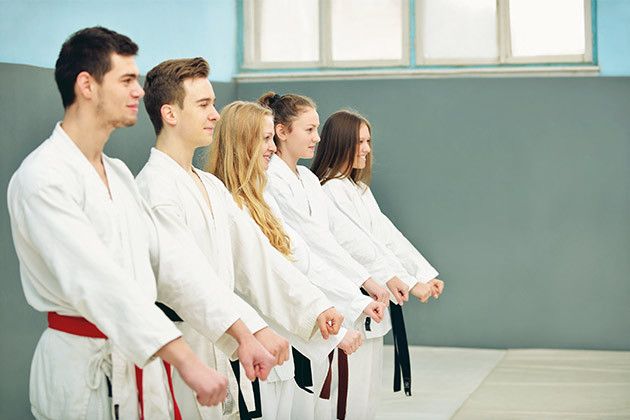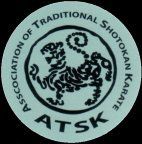Training & Fitness
Advanced Training Dates
What's Training All About?

Advanced Training Dates 2025
Advanced training sessions will take place at the following venues and dates:
Bedford Putoe Club: Wednesdays, 7.30-8.30 pm, Putnoe Heights Church & Community Centre, Putnoe Heights, Bedford. MK41 8EB.
12th March, 11th June, 24th September & 12th November
What's Training All About?
Successful Karate cannot be achieved if the mind isn't strong enough to master the body, or the body strong enough to carry out the activities demanded by Karate-do. Physical training is what we do to (a) learn the moves and techniques used in Karate-do, and (b) keep (or get!) fit. The action of physical training, where we require the body to withstand stresses it would not normally tolerate, demands the use of the mind, to push the body along.
This simple mastery, where the mind controls the actions of the body, is reflected in the words of Master Funakoshi:
Mazu jiko wo shire, shikoshite tao wo shire
- "Know yourself first, and then others".
Consider it this way: in a fight, the objective is to master your opponent. But if you cannot master yourself first, how can you hope to prevail against an enemy? Training helps us to know - or master - ourselves, and thus frees us to overcome all obstacles.
When Do We Train?
We train every day.
This may seem difficult to understand at first, but Master Funakoshi said:
Karate wa no goto shi taezu natsudo wo ataezareba moto no mizu ni kaeru
- "Karate is like hot water. If you do not give it heat constantly, it will again become cold water".
Of course, training every day in a Dojo (training hall) is a luxury few people have. So most of our training is done on our own, which requires good self-discipline. It is not easy, especially when we feel under the weather, or distracted, or bored, or whatever. But even when we are physically incapable of actively training, we can still reflect on our Karate, read about it, or run through a difficult Kata
in our mind. This, too, is training.
Your success with Karate will depend entirely on the effort you put in to it.
For the most part, we try to train together with like-minded Karate-ka
(students) in a Dojo. Beginners generally start with a single one-hour session per week. As they progress through the grades, this increases to two hours per week. Normally, this is the maximum training time that students will receive at any one Dojo; but as they achieve senior grade status, most serious students will start to visit other clubs within the Association, to extend their training to four, six, eight, or even more hours per week. This is particularly important once you reach your Brown belt (3rd Kyu).
As senior grades, we also learn by teaching.
This is a vital part of Karate. As a senior grade, you have learned much from your Sensei, and from your senior grade predecessors. It is right and proper (and very enjoyable) to pass on your knowledge to the junior grades following in your footsteps. Attending a junior lesson, and assisting Sensei with the instruction, is both beneficial and rewarding, and should be considered a vital part of every senior grade's training plan.
How Do We Train?
A typical training session in a Dojo begins with a warm-up routine.
This is mostly calisthenics, involving some vigorous jumping (up/down, side-to-side, forward/backward/, etc.), neck rotations, arm exercises, leg extensions, torso/hip movement, and so on. For junior beginer classes, we frequently play active, fun games (Bulldog being one favourite). When weather is fine, we may train ouside (facilities permitting).
This is followed by basics. These are geared to the grades of the students; thus beginners will concentrate on individual techniques (such as Choku Zuki, Age Uke, Mae Geri, etc.), while more advanced students will cover combination techniques, starting with Age Uke / Gyaku Zuki, and progressing to more complex examples, like Mae Geri / Kekomi / Shuto Uchi / Gyaku Zuki / Gedan Barai.
This is almost always followd by Kata, and again, the Kata performed will (generally) reflect the grades of the students. Thus, for example, White belts and Blue belts will practice Taikyoku Shodan, Green belts will practice Taikyoku Shodan
plus all the Heian Katas
up to Heian Yondan. Bunkai
(application) will also usually feature.
Kumite
(sparring) also has it's part, and numerous lessons will contain instruction in both the Kihon
Sets, and the Jiyu Ippon
Sets. Sometimes we look at Karate weapons, such as the Bo
and Jo.
When a grading is approaching, training naturally concentrates on the syllabus, but at other times, Sensei may decide to inroduce other martial arts techniques (from, for example, Judo), or self-defence moves, etc., to broaden the experience of the students.
Sometimes training is gruelling and tough, with much physical activity performed at high speed, non-stop.
We need this every now and then to ensure our physical edge is not lost. Other lessons, however, concentrate on honing techniques. Sensei might select a Kata, and concentrate on that for a whole lesson. This allows students to examine individual moves in detail, to practice those movements at slow speed, which helps the body develop a degree of muscle memory. Students can discuss with Sensei the benefits of these moves, and learn their application.
